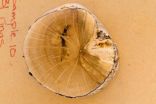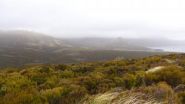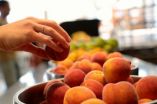(Press-News.org) Many have assumed that warmer winters as a result of climate change would increase the growth of trees and shrubs because the growing season would be longer. But shrubs achieve less yearly growth when cold winter temperatures are interrupted by temperatures warm enough to trigger growth.
"When winter temperatures fluctuate between being cold and warm enough for growth, plants deplete their resources trying to photosynthesize and end the winter with fewer reserves than they initially had. In the summer they have to play catch up," said Melanie Harsch, a University of Washington postdoctoral researcher in biology and applied mathematics. She is lead author of a paper on the subject recently published in PLOS ONE.
The roots are especially sensitive to temperature fluctuations, Harsch said. Warming winters result in higher root respiration, which uses up carbon reserves as plants make and release oxygen, leading to less carbon available during the regular growing season.
Harsch and her colleagues studied two species of shrubs on Campbell Island, an uninhabited UNESCO World Heritage site in the southwest Pacific Ocean about 375 miles south of New Zealand's mainland. They studied two large shrubs, Dracophyllum longifolium and Dracophyllum scoparium, which are evergreen broadleaf species that can grow up to about 15 feet tall and live up to 240 years.
Researchers found that while warmer, drier winters helped seedlings get established, it adversely affected growth of older plants.
"For growth to occur you need sufficient precipitation and temperature and nutrients. Growth should only happen during the summer on Campbell Island when temperatures are above 5 degrees Celsius," Harsch said. Five degrees C is about 40 F. "On Campbell Island most winters are cool and below this 5 degrees Celsius, so the plants are not active. The plants we studied are evergreen and there is little snow cover, so they are sensitive to changes in temperature."
In this study, researchers cut out discs, called "cookies," from just above the shrubs' root collar, and measured the width between each ring to determine growth. They found that plant growth decreased as winter temperatures went up.
"On Campbell Island the snow is ephemeral, so the plants usually are not covered," Harsch said. "If we're going to see an effect in changing winter conditions, we're going to see it at Campbell Island decades before we see it at, say, Mt. Rainier, where there is a lot of snow and winters are colder."
Harsch said plants in areas like Campbell Island may eventually adjust to warmer winters, but the transition period will be tough as temperatures bounce above and below what plants need to stay dormant, causing the plants to draw down their resources.
"It may eventually be warm enough in the winters so that plants can photosynthesize and grow year round, like they do in the tropics," she said. "It's this transition part that plants are not adapted for."
Harsch plans to do a follow-up study that would measure the microbes and carbon reserves in the soil, and manipulate snow packs to see how it affects establishment and growth.
"How much of this can our tree species withstand?" Harsch said. "Will summer growth eventually compensate for these hard winters, or is this some sort of extra stressor on trees that will be one more nail in the coffin? If you think of all the different factors of increasing vulnerability in climate change, is this really significant? We just don't know."
INFORMATION:
Co-authors are Matt McGlone and Janet Wilmshurst at Landcare Research in New Zealand. Harsch started the work while pursuing her doctorate at Lincoln University in New Zealand and finished the analysis at the UW. The work was supported in part by the National Science Foundation.
For more information, contact Harsch at harsch.melanie@gmail.com or 253-365-1555.
NSF grant: DEB-1103734.
Shrub growth decreases as winter temperatures fluctuate up
2014-05-20
ELSE PRESS RELEASES FROM THIS DATE:
Game changer: Patients of doctors who played online game had better control of blood pressure
2014-05-20
Boston, MA – Primary care providers who engaged in an online game to solve clinical cases about hypertension management improved blood pressure control of their patients in a shorter amount of time compared to non-gamers, according to a new study by researchers at Brigham and Women's Hospital (BWH) and the Veterans Affairs Boston Healthcare System.
The study was published May 20, 2014 in Circulation: Cardiovascular Quality and Outcomes.
"This study is the first to show that an online educational game among medical professionals can improve the health measures of their ...
Screen of existing drugs finds compounds active against MERS coronavirus
2014-05-20
WHAT:
Clinicians treating patients suffering from Middle East respiratory syndrome (MERS) currently have no drugs specifically targeted to the MERS coronavirus (MERS-CoV), a virus first detected in humans in 2012 that has since caused 614 laboratory-confirmed infections, including 181 that were fatal, according to the World Health Organization. The case count escalated sharply in the spring of this year, and the first cases in the United States were announced in early May. To address the urgent need for therapies, researchers supported by the National Institutes of Health ...
Detroit Lions help rebuild city with innovative gridiron giving, U-M researchers say
2014-05-20
ANN ARBOR—The Detroit Lions' new model of philanthropy and community engagement may prove to be a touchdown for the city of Detroit.
A new case study of corporate social responsibility in sport by University of Michigan researchers uses the Lions as an exemplar of a professional sports team reinventing its charitable giving and community relations approach in hopes of making a bigger impact on the community.
In 2012, the Lions created the "Living in the City" campaign—a new model of corporate philanthropy that emphasizes deeper relationships with a small core group ...
UofL researcher and team explore broader definition of successful aging
2014-05-20
LOUISVILLE, Ky. – An aging population poses challenges for governments around the globe as nations grapple with how to satisfy the physical, social and economic needs of older adults. About 126 million adults 65 years and older live in China - the country with the largest population of senior citizens, while 40 million adults 65 years and older live in the United States.
In an article published today in Journal of Transcultural Nursing, University of Louisville School of Nursing assistant professor Valerie Lander McCarthy, PhD, RN; Ji Hong, MSN, a visiting scholar from ...
With climate changing, southern plants outperform northern
2014-05-20
Can plants and animals evolve to keep pace with climate change? A study published May 19 in the journal Proceedings of the National Academy of Sciences shows that for at least one widely-studied plant, the European climate is changing fast enough that strains from Southern Europe already grow better in the north than established local varieties.
Small and fast-growing, Arabidopsis thaliana is widely used as the "lab mouse" of plant biology. The plant grows in Europe from Spain to Scandinavia and because Arabidopsis is so well-studied, there is a reference collection of ...
The added value of local food hubs
2014-05-20
(Santa Barbara, Calif.) — As the largest purchaser of wholesale produce in Santa Barbara County, UC Santa Barbara's residential dining services provided the perfect avenue for a pilot project incorporating local pesticide-free or certified organic produce into an institutional setting.
The idea was conceived almost 10 years ago, when a group of students approached environmental studies professor David Cleveland about becoming a faculty adviser for student-led sustainable living classes. The group wanted to explore how to bring more local organic food in the dining halls. ...
Central Valley sees big drop in wintertime fog needed for fruit and nut crops
2014-05-20
BERKELEY — California's winter tule fog -- hated by drivers, but needed by fruit and nut trees -- has declined dramatically over the past three decades, raising a red flag for the state's multibillion dollar agricultural industry, according to researchers at the University of California, Berkeley.
Crops such as almonds, pistachios, cherries, apricots and peaches go through a necessary winter dormant period brought on and maintained by colder temperatures. Tule fog, a thick ground fog that descends upon the state's Central Valley between late fall and early spring, helps ...
New analysis eliminates a potential speed bump in quantum computing
2014-05-20
A quantum particle can search for an item in an unsorted "database" by
jumping from one item to another in superposition, and it does so
faster than a classical computer ever could.
This assertion assumes, however, that the particle can directly hop from any item to any other. Any restriction on which items the particle can directly hop to could slow down the search.
"Intuition says that a symmetric database allows the particle to hop freely enough to retain the quantum speedup, but our research has shown this intuition to be false," says Tom Wong, a physicist at ...
Penn team identifies promising new target for gum disease treatment
2014-05-20
Nearly half of all adults in the United States suffer from the gum disease periodontitis, and 8.5 percent have a severe form that can raise the risk of heart disease, diabetes, arthritis and pregnancy complications.
University of Pennsylvania researchers have been searching for ways to prevent, half and reverse periodontitis. In a report published in the Journal of Immunology, they describe a promising new target: a component of the immune system called complement. Treating monkeys with a complement inhibitor successfully prevented the inflammation and bone loss that ...
A full serving of protein at each meal needed for maximum muscle health
2014-05-20
Most Americans eat a diet that consists of little to no protein for breakfast, a bit of protein at lunch and an overabundance of protein at dinner. As long as they get their recommended dietary allowance of about 60 grams, it's all good, right?
Not according to new research from a team of scientists led by muscle metabolism expert Doug Paddon-Jones of the University of Texas Medical Branch at Galveston. This research shows that the typical cereal or carbohydrate-dominated breakfast, a sandwich or salad at lunch and overly large serving of meat/protein for dinner may not ...





